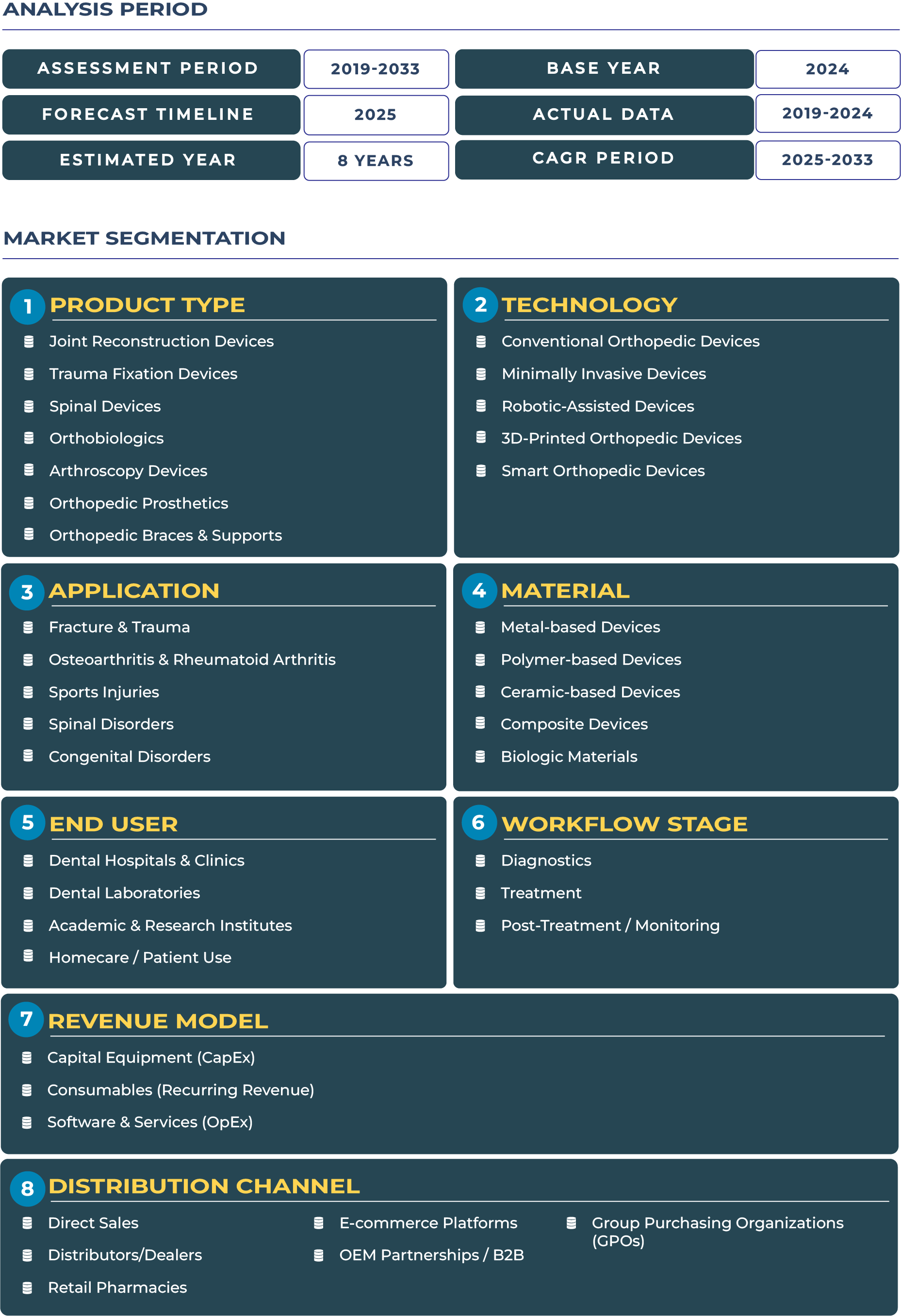Report Format:
![]()
![]() |
Pages: 110+
|
Pages: 110+
India Orthopedic Devices Market Outlook: Insurance Coverage and Affordable Implants Drive India Orthopedic Devices Industry Expansion
India stands at a transformative point in its healthcare journey, where affordability and insurance expansion are reshaping access to advanced medical technologies. The orthopedic devices market is one of the most prominent beneficiaries of this shift, given the rising incidence of musculoskeletal disorders, trauma cases from road accidents, and lifestyle-driven joint ailments. With growing awareness and improved healthcare penetration, orthopedic devices are no longer seen as premium interventions limited to urban elites. Instead, they are progressively becoming part of broader care pathways across India’s diverse population, supported by both public schemes and private sector expansion.
The India orthopedic devices market is projected to expand from USD 1.42 billion in 2025 to USD 3.33 billion by 2033, recording an impressive CAGR of 11.2% during 2025–2033. This growth is driven by a combination of rising insurance penetration, affordability initiatives, and the emergence of local manufacturers offering lower-cost alternatives to imported implants. Initiatives under Ayushman Bharat – Pradhan Mantri Jan Arogya Yojana have played a vital role in expanding access to orthopedic surgeries by reducing out-of-pocket costs for millions of patients. Additionally, the country’s large patient pool, particularly its ageing population, is fueling demand for joint reconstruction and spinal care solutions. Urbanization, coupled with sedentary lifestyles, has increased cases of knee osteoarthritis and spinal disorders, while rising accident rates in both urban and rural India create a consistent need for trauma fixation devices. Together, these drivers are setting the stage for long-term sustainable growth of the orthopedic devices industry in India.
Drivers & Restraints: Evaluating the Forces Shaping India Orthopedic Devices Sector
Growth Drivers Anchored in Access, Infrastructure, and Rising Patient Awareness
One of the strongest growth drivers for India Orthopedic Devices market is the large underpenetrated population. Millions of patients suffering from chronic musculoskeletal conditions remain untreated, presenting significant growth opportunities. Rising insurance coverage under government and private schemes has made advanced orthopedic surgeries financially feasible for lower- and middle-income households. Moreover, the rapid expansion of private hospital chains across tier-2 and tier-3 cities has brought high-quality orthopedic care closer to semi-urban and rural populations. The increasing focus on elective surgeries, particularly knee and hip replacements, highlights India’s growing capacity to address orthopedic needs with modern devices.
Challenges Rooted in Affordability, Distribution, and Reimbursement Gaps
Despite robust growth, the orthopedic devices ecosystem in India is not without restraints. Price sensitivity remains the biggest barrier, as a large proportion of the population still struggles with affordability even when insurance is available. Variability in reimbursement frameworks between states and hospitals creates inconsistency in patient access to advanced implants. Additionally, supply chain and logistical challenges in reaching tier-2 and tier-3 centers hamper the distribution of advanced devices beyond metropolitan markets. These limitations, if not addressed, risk slowing the pace of equitable adoption across the broader healthcare landscape in India.
Trends & Opportunities: Emerging Pathways in India Orthopedic Devices Ecosystem
Key Trends Shaping the Industry’s Growth Trajectory
The orthopedic devices landscape in India is undergoing a visible transformation marked by multiple emerging trends. Rapid expansion of private hospital networks in tier-2 and tier-3 cities has widened the base of patients accessing orthopedic surgeries. Domestic low-cost implant manufacturing, supported by the government’s “Make in India” initiative, is reducing reliance on imports while bringing down costs of trauma fixation and joint reconstruction implants. Furthermore, innovative ambulatory and knee care initiatives in urban areas are allowing patients faster recovery and cost-effective surgical options. These trends are reinforcing India’s position as a key growth hub in the global orthopedic devices industry.
Opportunities Unlocking Future Market Potential
Significant opportunities exist in India Orthopedic Devices sector. The development of low-cost patient-matched implants offers an affordable solution tailored to India’s diverse patient demographics. Local manufacturing and surgeon training programs are expected to enhance the adoption of advanced techniques in both metropolitan and semi-urban hospitals. Meanwhile, the exploration of outcome-based financing pilots by insurers and healthcare providers may further reduce patient costs, ensuring wider uptake of devices such as spinal fixation systems and orthopedic prosthetics. These opportunities underscore the importance of innovation, collaboration, and policy support in accelerating growth.
Competitive Landscape: Balancing Local Innovation and Global Expertise in India Orthopedic Devices Market
The competitive dynamics of India Orthopedic Devices sector reflect a balance between multinational corporations and domestic manufacturers. Global leaders such as Johnson & Johnson MedTech continue to maintain strong presence through advanced joint reconstruction and spinal solutions, while Indian firms are carving a niche in affordable trauma fixation and prosthetic devices. Recent developments highlight strategies such as local manufacturing combined with tiered pricing models to unlock volume in a price-sensitive market. Training programs for orthopedic surgeons in metro cities are also enabling faster adoption of minimally invasive devices. Additionally, outcome-based studies by both local and international players are reinforcing clinical credibility and supporting reimbursement pathways. The sector’s competitive landscape clearly indicates a shift toward ecosystem partnerships that balance affordability with technological sophistication.







